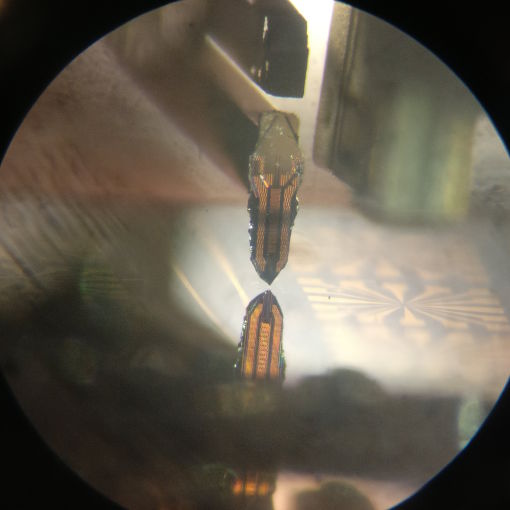
Near-Field Scanning Microwave Microscope at 30mK
Scanning techniques such as atomic force microscopy (AFM) or scanning tunnelling microscopy (STM) offer a wide range of material investigation possibilities. Depending on the environmental conditions and the required scanning resolution scanning probe microscopes are hard to design and setup and not seldom homemade devices, adapted to their special proposes and requirements. A new low temperature near-field scanning microwave microscope working at 30 mK, designed to meet emerging needs of the quantum technologies sector, was now developed by the group of Sebastian de Graaf at NPL (National Physical Laboratory, Teddington, UK) in collaboration with the group of Prof. Sergey Kubatkin (Chalmers University of Technology, SE). It combines microwave characterization up to 6 GHz with STM or AFM techniques. The environment of a dilution cryostat makes special demands on the stability and stiffness of the used components. The group used a set of ANPx100 and ANPz100 nanopositioners (former versions of the ANP101 positioners) to align the sample with the tip in x, y, and z direction and a small ANPz51 positioner for the RF waveguide positioning. First verifications of the instrument showed the capability to image dielectric contrast down to the single microwave photon regime.
This measurement was realized with the ANPx101/LT/HV - linear x-nanopositioner, the ANPz101/LT/HV - linear z-nanopositioner, and the ANPz51/LT/HV - linear z-nanopositioner.
Further reading:
S. Geaney et al; Scientific Report 9, 12539 (2019)
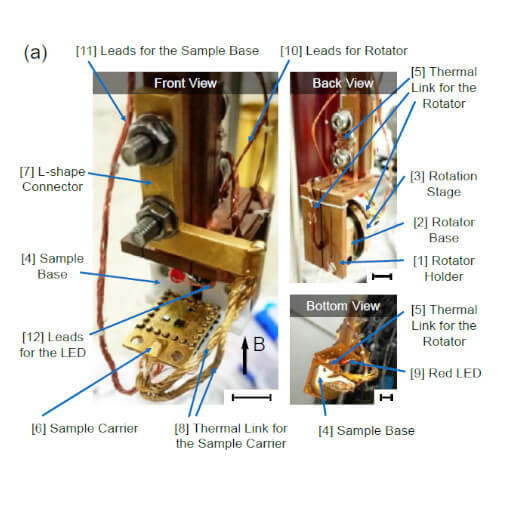
Rotating transport measurement setup at 25mK
When designing a setup for mK applications material choice and thermalization is crucial. Titanium becomes superconducting at temperatures below 400 mK consequently, the thermal contact to the sample is not ensure anymore. At Peking University (Beijing, China), Dr. Pengjie Wang from Xi Lin group has chosen the beryllium-copper version of the ANR101 positioner with resistive readout to realize their low-electron-temperature sample rotation system for transport measurements inside a dilution cryostat. The rotator allows to orient the sample in-situ with respect to a high magnetic field of up to 10 T.
The dilution cryostat with a diameter of 81 mm offers the required space for the rotator setup, see picture. The sample holder is designed for the use of up to four sample, each 5 mm x 5 mm large, a red LED is installed to illuminate the samples at 4 K for an easier orientation. The measured electron temperature in the setup is 25 mK, the same as the environmental temperature.The setup is designed for transport measurements and material characterization at ultra-low electron temperatures. A first application shows the tilt-induced localization and delocalization of the second Landau level of the two-dimensional electron gas - an experiment for which a pressurized liquid ³He cell had been necessary elsewise.
(Figure reproduced from Rev. Sci. Instrum. 90, 023905 (2019); doi: 10.1063/1.5083994, with the permission of AIP Publishing)
This measurement was realized with the ANR101/RES/LT - rotator (360° endless).
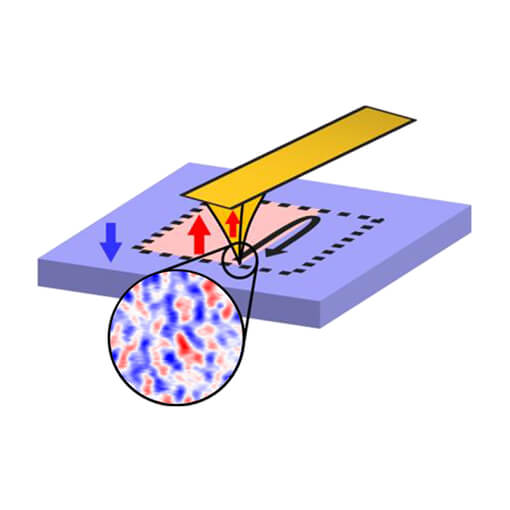
Quantized Conduction on Domain Walls of a Magnetic Topological Insulator
In a paper published in Science, researchers from the University of Tokyo and RIKEN (Japan) have studied “Quantized conduction on domain walls of a magnetic topological insulator” using an attoAFM/MFM in a 3He-cryostat down to 500 mK. In their paper, Yasuda et al. designed and fabricated magnetic domains in the quantum anomalous Hall state, and proved the existence of the chiral one-dimensional edge conduction along the domain walls through transport measurements.
This discovery would permit fully electrical control of the mobile domain walls and chiral edge states, which may lead to the realization of low-power-consumption spintronic, memory and quantum information processing devices in the future.
This measurement was realized with the attoAFM I.
Further reading:
Yasuda et al., Science 358, 1311–1314 (2017)
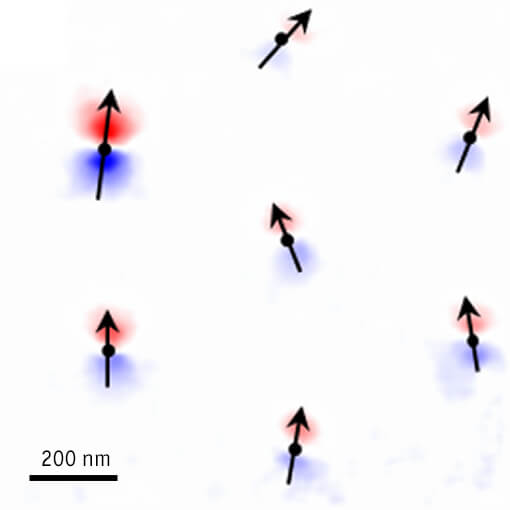
Dynamic Visualization of Nanoscale Vortex Motion using attoSTM in an attoLiquid3000
Matias Timmermans and co-workers invented an innovative technique removing the lack of temporal resolution in STM imaging. They used an attoSTM in an attoLIQUID3000 3He cryostat to measure and study vortex motion in 2H-NbSe2 on a much shorter time scale. By applying a small AC magnetic field they induced a periodic movement of the vortices. The external perturbation results in a distinct smearing of the vortex in the images. Instead of collecting several consecutive images, the tunnelling current is recorded at each point over three cycles of the excitation. The exceptional thermal and spatial stability of the attoSTM in the attoLiquid3000 allows further analysis of the time dependence of this signal at each point. Using an additional lock-in technique more details and understanding of the vortex motion is revealed. By mapping the first and a second harmonic of the tunnelling signal (see upper figures), they were able to visualize changes of the vortex lattice when the vortex density is increased by increasing the DC magnetic field.
In a next step, they used the AC excitation as a time reference to track the motion of individual vortices in time. This results in time resolved snapshots of the vortex motion, which allows them to construct a movie frame by frame. This visualization procedure is unprecedented and promises a much better understanding of the dynamical behaviour of the superconducting condensate (see lower figures). Contrary to the expectation the vortex does not move in a line but follows a circular motion, due to a potential created by atoms and/or vortices.
This measurement was realized with the attoAFM III.
Confocal Microscopy on Quantum Dots at 50 mK
A customized attoCFM II module was implemented into a dilution refrigerator for the detailed investigation of quantum dots in an ultra-low temperature environment and magnetic fields of up to 7 T. The figure shows differential transmission measurements on a InAs quantum dot embedded in a GaAs matrix at 50 mK. The pronounced deviation from the lineshape as expected from the quantum confined Stark effect is due to many-particle interactions.
Further reading:
C. Latta et al., Nature 474, 627 (2011)
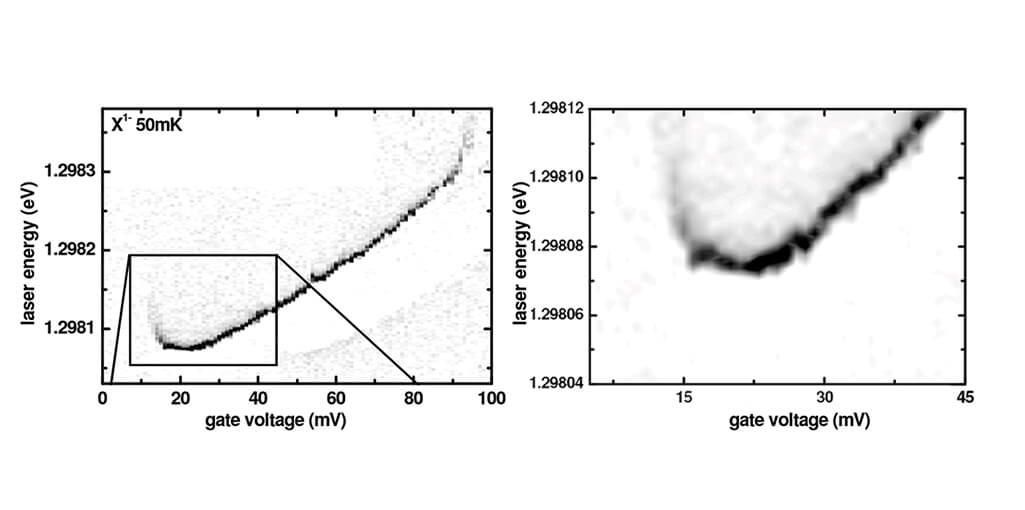
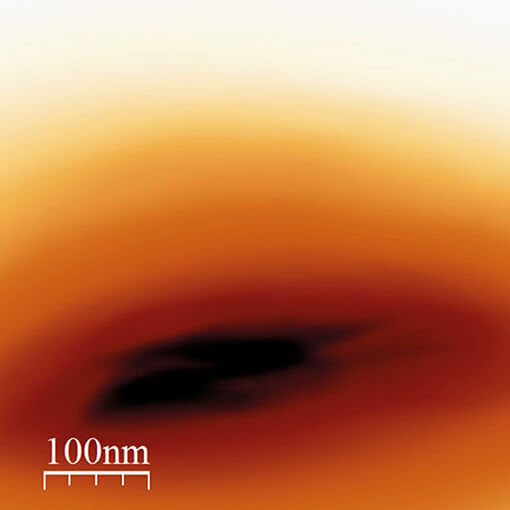
Imaging fractional incompressible stripes in integer quantum Hall effect
Nicola Paradiso, Stefan Heun, and co-workers measured the fractional quantum Hall effect in quantum point contacts using an attoAFM III in an attoLIQUID3000 at very low temperature (300 mK) and high magnetic field (≈8 T). They demonstrated that fractional features were unambiguously observed in every integer quantum Hall constriction. These ground-breaking Scanning Gate Microscopy experiments pave the way to a better understanding of the role of fractional phases in the field of coherent quantum transport!
This measurement was realized with the attoAFM III.
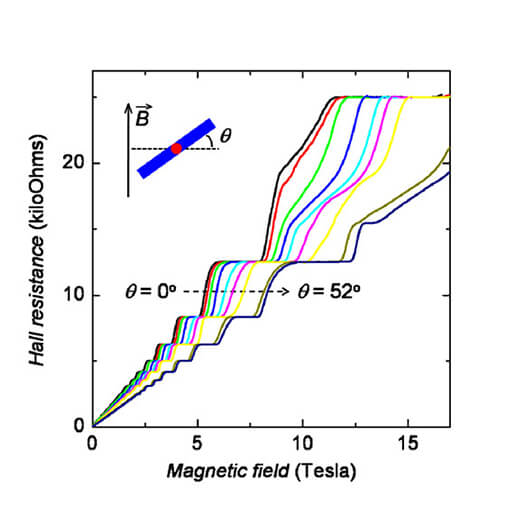
Angle-dependent transport measurements at 40 mK
Based on an attocube systems rotator ANR30/LT a rotation stage for angle-dependent transport measurements in magnetic fields up to 33 T and temperatures down to 40 mK was built at the user facility of the High Field Magnet Laboratory in Nijmegen.
The mixing chamber of the commercially available dilution refrigerator from Leiden Cryogenics offers only a limited space of 17 mm in diameter. Hence, the ultra compact attocube rotator ANR30/LT is the positioner of choice for this task. The rotator is fixed on a plastic (Hysol) dilution refrigerator insert.
This measurement was realized with the ANR31/LT rotator made from Titanium and CuBe.
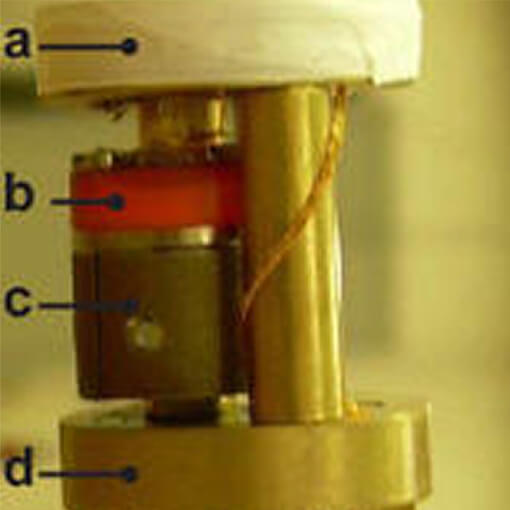
Performance Test of the ANPz30/LT at 35 mK and 15 Tesla
The precise performance of nanopositioning elements is of great importance in order to realize instrumental setups which work reliably under extreme environmental conditions. Although attocube systems’ positioners have been tested at low temperatures down to 10 mK and at high magnetic fields up to 28 Tesla, their successful performance has never been demonstrated when both environmental conditions were simultaneously applied. A real challenge, furthermore, is to carry out such a test in a 3He/4He environment due to the fact that 3He carries a magnetic spin which becomes polarized in magnetic fields. This influence on the positioner’s operation was investigated for the first time in this application.
This measurement was realized with the ANPz30/LT - linear z-nanopositioner.
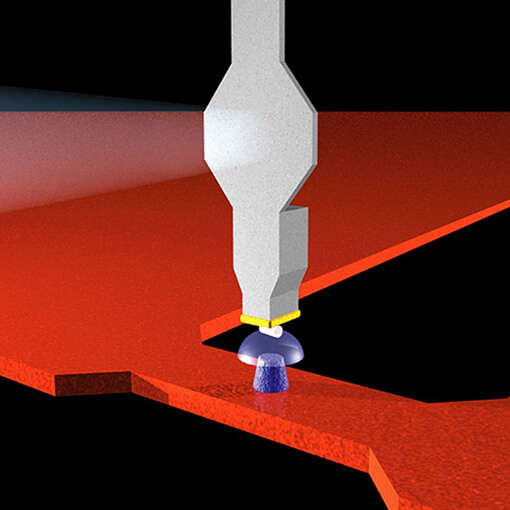
Magnetic Resonance Imaging of Nanoscale Virus at 300 mK
attocube’s ANPx51 positioners were used in an MRFM setup with the task to precisely and reliably position a magnetic tip and a copper nanowire to close proximity of an ultra-sensitive cantilever. The MRFM setup was applied to investigate and reconstruct the 1H spin distribution of Tobacco Mosaic Virus particles, representing a 100-million fold improvement in volume resolution over conventional MRI.
This measurement was realized with the ANPx51/LT - linear x-nanopositioner.
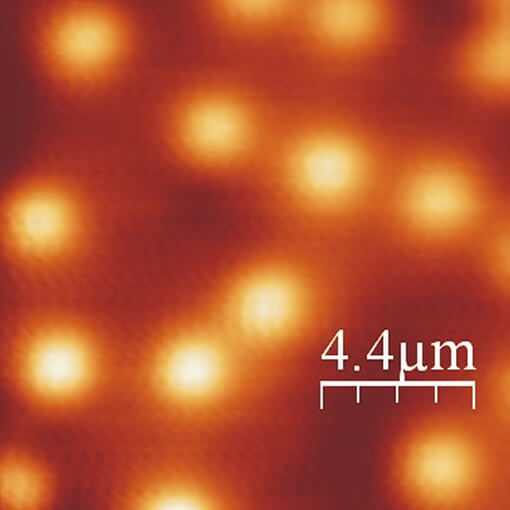
Scanning Hall Probe Microscopy at 300 mK with ANP positioners
The magnetic properties of superconducting and ferromagnetic materials at ultra-low temperatures represent some of the most interesting contemporary problems in condensed matter physics. These properties are typically investigated using a magnetic force microscope or a scanning Hall probe microscope (SHPM). In this note, we report on a self-built SHPM capable of working at temperatures as low as 300 mK and magnetic fields of up to 10 T, while still having sub-micron lateral spatial resolution.
This measurement was realized with the ANPx101/LT - linear x-nanopositioner, and the ANPz102/RES/LT - linear z-nanopositioner.
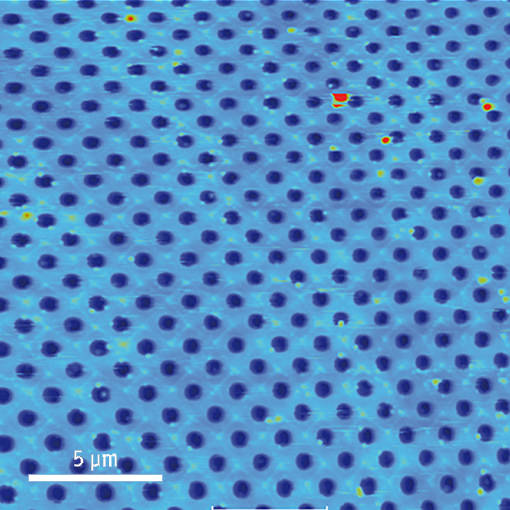
attoAFM I Mounted on Mixing Chamber
This scan above nicely demonstrates the stability of a complete system, an attoAFM I together with a LD400 cryo-cooler from BluFors Cryogenics. For this 25 x 25 µm2 (800 x 800 pixel) scan, the pulse-tube cooler was enabled the whole time. The temperature was stable at ≈40 mK measured at the mixing chamber - it was slightly higher due to the higher scan speed of close to 1 µm/s.
(attocube applications in collaboration with BluFors Cryogenics, 2014)
This measurement was realized with the attoAFM I.
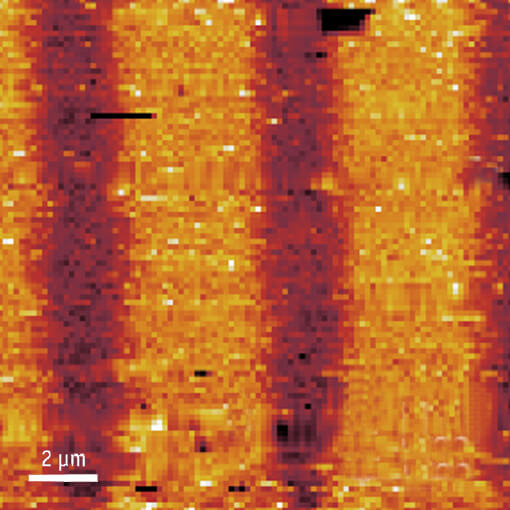
attoAFM III in Toploading Insert
The depicted data was taken with a tuning fork attoAFM III specifically designed for mK operation. The extremely sensitive microscope was mounted on a toploading insert (see images and project description on the left page), which ensures a much higher usability in terms of turnaround times upon tip and sample exchange than if it were mounted directly on the mixing chamber. The sample temperature in the toploading DR was 55 mK during the scan at 100 nm/s. The images nicely demonstrates that the delicate microscope works reasonably well even under these extreme conditions.
This measurement was realized with the attoAFM III, and the Tuning-fork-based AFM for Scanning Gate Microscopy.
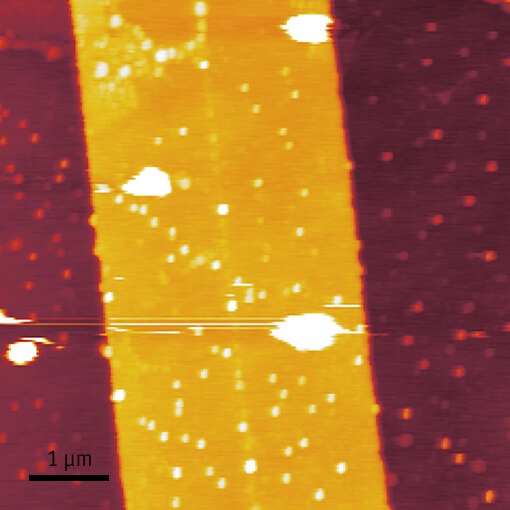
attoAFM III Mounted on Mixing Chamber
This AFM-topography test-measurement of an 20 nm high calibration grating was performed in a pulse-tube based dilution fridge from Leiden Cryogenics. Even though the sample was scanned with 3 µm/s, the temperature did not rise above 80 mK, while the base temperature of the (here not optimized) braid cooled sample was at around 62 mK. Geophone measurements verified the low vibrations of the platform and showed that it is a suitable approach for high resolution, ultra-low temperature AFM-type experiments.
(attocube applications in collaboration with Leiden Cryogenics, 2011)
This measurement was realized with the attoAFM III, and the Tuning-fork-based AFM for Scanning Gate Microscopy.

Scanning Gate Microscopy at 300 mK
In this measurement, an attoAFM III was operated inside an attoLIQUID3000 cryostat at 300 mK in scanning gate microscopy mode (SGM) - investigating the trajectory and interaction of edge channels of a split-gate quantum point contact (QPC) device in the Quantum Hall (QH) regime. By scanning the SGM tip over the surface of the QPC at constant height and by simultaneously measuring and plotting the source-drain current, conductance maps were obtained. The image to the left is an example of such a conductance map depicting the characteristic branched-flow of electrons at zero magnetic field, which in turn shows electron interference fringes and the actual electron path (T = 400 mK, 2DEG density n2D = 3.37 x 1011 cm-2).
(Data and images were generously provided by S. Heun et al., NEST, CNR-INFM and Scuola Normale Superiore, Pisa, Italy.)
This measurement was realized with the Tuning-fork-based AFM for Scanning Gate Microscopy.
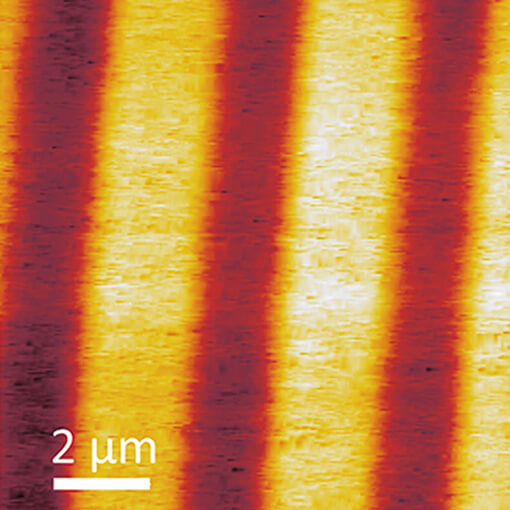
attoAFM/CFM in Toploading Insert
The presented data was taken with a mk-compatible version of the attoAFM/CFM mounted on a toploading insert of a Leiden Cryogenics closed-cycle dilution refrigerator. The sample temperature was 60 mK during an AFM scan with a speed of 400nm/s. The images nicely demonstrates that the delicate microscope works very well even under these extreme conditions.
This measurement was realized with the attoAFM/CFM.
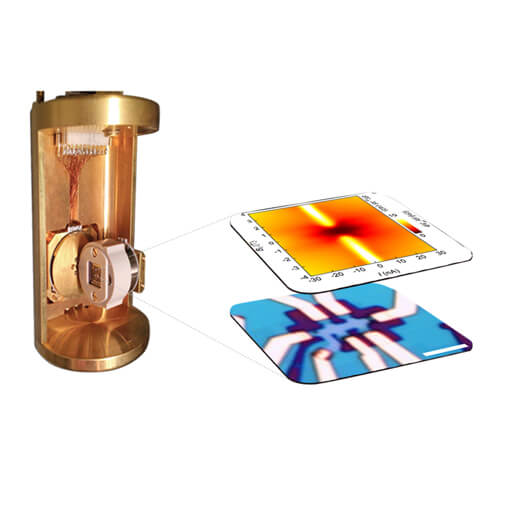
Van der Waals heterostructure under rotation at 40 mK
Understanding the mechanism of high temperature (high Tc) superconductivity is a central problem in condensed matter physics. Van der Waals heterostructures provide novel materials as model systems for quantum phenomena. An international collaboration (Berkeley, Stanford, Shanghai, Tsukuba, Seoul) reports in Nature signatures of tunable superconductivity in these special heterostructures, detected via a sharp drop in the resistivity and a plateau in the I-V curve below 1 K.
The transport measurements are performed in a dilution cryostat with a base temperature of 40 mK achieved through careful filtering. For in-plane measurements, the atto3DR double sample rotator was used, which conveniently allows for using the full field of a single solenoid in an arbitrary orientation. The authors find transitions from the candidate superconductor to Mott insulator and metallic phases, proving that the TLG/hBN superlattice provides a unique model system to study the triangular Hubbard model and its relation to unconventional superconductivity as well as potentially novel electronic states.
This measurement was realized with the atto3DR.
Further reading:
Guorui Chen, et al.; Nature, 572, 215–219 (2019)
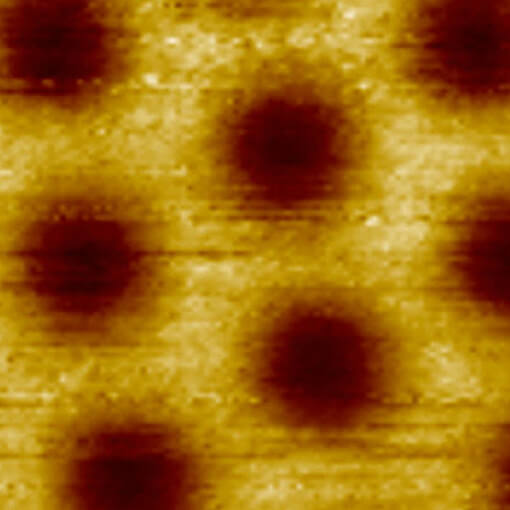
Scanning Tunneling Spectroscopy and Vortex Imaging on NbSe2 with attoAFM III / STM I at 315 mK
Scanning Tunneling Spectroscopy (STS) is a useful tool to characterize material properties, especially on superconductors at ultra low temperatures. In a series of experiments STS measurements as well as vortex imaging on NbSe2 have been performed at a temperature of only 315 mK. The tests show excellent stability of the combined attoAFM/STM microscope setup as well as the possibility to apply stable voltages in the micro-Volt range.
This measurement was realized with the Tuning-fork-based AFM for Scanning Gate Microscopy.

